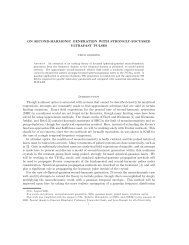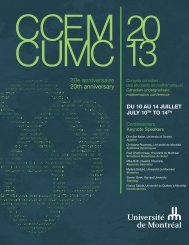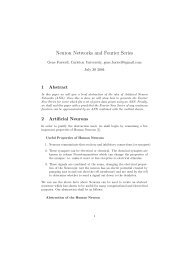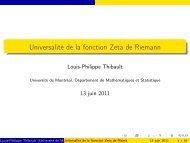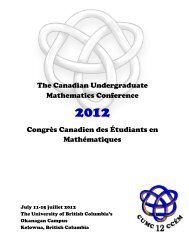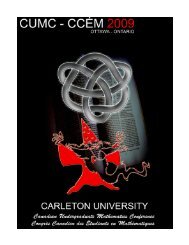The Pythagorean Proposition - CUMC
The Pythagorean Proposition - CUMC
The Pythagorean Proposition - CUMC
You also want an ePaper? Increase the reach of your titles
YUMPU automatically turns print PDFs into web optimized ePapers that Google loves.
<strong>The</strong> <strong>Pythagorean</strong> <strong>Proposition</strong><br />
Marcus Emmanuel Barnes<br />
August 14, 2004<br />
Abstract<br />
<strong>The</strong> <strong>Pythagorean</strong> theorem is taught to schoolchildren around the world.<br />
One could say that the <strong>Pythagorean</strong> theorem is one of the first significant<br />
theorems that students learn. Not only is the theorem beautiful in its<br />
own right, it also leads the student to many other areas of mathematics,<br />
including trigonometry and analytic geometry. In celebration of this<br />
classical and useful result, three proofs of the <strong>Pythagorean</strong> theorem of<br />
different flavors will be presented.<br />
Introduction<br />
<strong>The</strong> genesis of this paper started one day while I was browsing through the<br />
geometry books in the Stacie Science Library at York University in Toronto. I<br />
came across a most curious book by a gentleman named Elisha Scott Loomis.<br />
Loomis went to the effort to compile in one place proofs of the <strong>Pythagorean</strong><br />
theorem. He was able to pack 370 different “demonstrations” of the <strong>Pythagorean</strong><br />
theorem into one book, which happens to be called the “<strong>The</strong> <strong>Pythagorean</strong><br />
<strong>Proposition</strong>”. I dedicate this paper, based on my talk at the 2004 Canadian<br />
Undergraduate Mathematics Conference in Halifax, hosted by Dalhousie University,<br />
to the book,“<strong>The</strong> <strong>Pythagorean</strong> <strong>Proposition</strong>”.<br />
You may first remember the <strong>Pythagorean</strong> theorem being taught to you in<br />
elementary school around the concept of a variable was being introduced. <strong>The</strong><br />
<strong>Pythagorean</strong> theorem is one of the first very powerful and elegant theorems that<br />
one encounters in elementary school mathematics (even if the theorem was not<br />
proven to you).<br />
One could not do trigonometry without the <strong>Pythagorean</strong> <strong>The</strong>orem, since<br />
one way of defining the trigonometric functions is based on the sides of a right<br />
angle triangle. <strong>The</strong> fundamental connections between the trigonometric functions<br />
are also derived using the <strong>Pythagorean</strong> theorem (for example, think of the<br />
<strong>Pythagorean</strong> identity sin 2 (x) + cos 2 (x) = 1). If you see a purported proof of<br />
the <strong>Pythagorean</strong> theorem using trigonometric methods, one should, to say the<br />
least, be skeptical of the validity of the proof.<br />
Trigonometry leads one right into higher mathematics and physics, especially<br />
in areas where periodic phenomena must be described. <strong>The</strong> <strong>Pythagorean</strong><br />
1
theorem is also a road into the study of analytic geometry, as one measures distances<br />
between points in the Euclidean plane with the Euclidean metric, that<br />
is, if you are given two points (x 1 ,x 2 ) and (y 1 ,y 2 ), the distance between these<br />
two points is √ (y 1 − x 1 ) 2 +(y 2 − x 2 ) 2 .<br />
It would be hard to argue otherwise that the <strong>Pythagorean</strong> theorem is among<br />
the most celebrated mathematical propositions of all time, having come down to<br />
us from antiquity. One can picture a scenario where two young school children<br />
are on a school bus arguing over who is smarter:<br />
Child 1: “Oh yeah! E = mc 2 .”<br />
Child 2: “Well, a 2 + b 2 = c 2 . So there!”<br />
It would be a safe bet to assume that Child 1 does not know the meaning<br />
of Einstein’s famous equation relating the mass of an object with the amount<br />
of energy it contains. A better bet would be to assume that Child 2 knows the<br />
meaning of a 2 + b 2 = c 2 , an equation that has more practical applications to<br />
everyday life. Child 2 going forth into the world with the <strong>Pythagorean</strong> theorem<br />
in her tool belt of mathematical skills would most likely live a more comfortable<br />
life than her school mate, Child 2.<br />
Now we will get to the heart of this paper. In celebration of the <strong>Pythagorean</strong><br />
theorem, three proofs of different natures will be presented. <strong>The</strong> first proof will<br />
be a “visual proof”; the second will be an algebraic proof; the third, a geometric<br />
proof. Note that the classification of the “algebraic” and “geometric” proofs<br />
respectively, is the classification given to them by Loomis in his book [1].<br />
<strong>The</strong> Visual ‘Proof’<br />
<strong>The</strong> word proof in the the title of this section is in scare-quotes for those readers<br />
who have qualms about visual proofs. <strong>The</strong> proof given here is adapted from the<br />
Chou pei suan ching as presented in [2]. <strong>The</strong> Chou pei suan ching is one of the<br />
earliest textual sources for the history of Chinese mathematics that is known to<br />
exist. <strong>The</strong> author of the proof is unknown, but the author probably lives some<br />
time during the years from around 500 to 200 B.C.E. (See Figure 1).<br />
a<br />
Figure 1<br />
b<br />
2
A short glance at the visual proof may have already shown you the validity of<br />
the <strong>Pythagorean</strong> theorem. If you have trouble deciphering the proof, observe<br />
the following. Square a is supposed to be dissected into 4 congruent right-angled<br />
triangles (the blue regions) plus the squares on the sides of the legs on one of<br />
the triangles (the green and yellow inner regions). Now square b is supposed to<br />
be congruent to square a. Square b is dissected into 4 congruent right-angled<br />
triangles (the blue regions) that are congruent to the 4 congruent right-angled<br />
triangles in square a, plus the square on the hypotenuse of one of the 4 congruent<br />
right-angled triangles. <strong>The</strong> areas of square a and square b are equal because<br />
square a and square b are congruent. Subtracting the congruent triangles from<br />
both square a and square b leaves us with the squares on the legs of one of the<br />
4 congruent triangles (the yellow and green squares) in what used to be square<br />
a and with the square on the hypotenuse (the magenta square) in what used<br />
to be square b. <strong>The</strong> regions left in what used to be square a must be equal<br />
to the region left in what used to be square b. Thus we have proven that for<br />
a right-angled triangle, the squares on the legs of the triangle are equal to the<br />
square on the hypotenuse. This is the <strong>Pythagorean</strong> theorem.<br />
<strong>The</strong> Algebraic Proof<br />
<strong>The</strong> algebraic proof presented here is proof number 38 from Loomis’ book [1].<br />
Refer to Figure 2 in what follows.<br />
C<br />
b<br />
a<br />
We have by similar triangles that<br />
A<br />
c<br />
Figure 2<br />
AD<br />
AC = AC<br />
AB .<br />
So, AC 2 = AD · AB. We also have by similar triangles that<br />
BD<br />
BC = BC<br />
BA .<br />
Hence, BC 2 = BD · BA. <strong>The</strong>refore,<br />
AC 2 + BC 2 = AD · AB + BD · BA =(AD + DB) · AB = AB 2 .<br />
In conclusion, we have a 2 + b 2 = c 2 and our proof is complete.<br />
D<br />
B<br />
3
<strong>The</strong> Geometric Proof<br />
We now come to the last proof of this paper. <strong>The</strong> geometric proof presented<br />
presently is proof number 220 from Loomis’ book [1]. Refer to Figure 3 in what<br />
follows.<br />
C<br />
A<br />
B<br />
L<br />
N<br />
G<br />
K<br />
M<br />
Figure 3<br />
Given a right-angled triangle △ABC and the square on its hypotenuse, draw a<br />
line parallel to CB through G and a line parallel to AC through K. MarkasM<br />
the point where these two lines meet. Now extend AC to meet the line MG at<br />
L and extend CB to meet the line MK at N. We now have a square CLMN.<br />
Next observe that<br />
ABKG = CLMN − 4 · 1 · CB · CA<br />
2<br />
= (CB + CA) 2 − 2 · CB · CA<br />
= CB 2 +2· CB · CA + CA 2 − 2 · CB · CA.<br />
Note that ABKG = AB 2 . <strong>The</strong>refore AB 2 = BC 2 + CA 2 , thus proving the<br />
<strong>Pythagorean</strong> theorem.<br />
4
Conclusion<br />
Admittedly, the content of this paper was rather elementary for a paper that<br />
was presented at an undergraduate conference. However, as this paper was<br />
presented during the first conference slot on the morning of the first day of the<br />
conference, it served the purpose of waking up the conference participants gently<br />
and getting them ready for the rest of an enjoyable and successful conference.<br />
Besides, who can resist a nice theorem with many elementary and elegant proofs<br />
— not me.<br />
References<br />
[1] Loomis, Elish Scott, <strong>The</strong> <strong>Pythagorean</strong> <strong>Proposition</strong>: Its Demonstration<br />
Analyzed and Classified and Bibliography of Sources for Data of the Four<br />
Kinds of ‘Proofs’, National Council of Teachers of Mathematics, Washington,<br />
DC, 1968.<br />
[2] Nelson, Roger B., Proof Without Words: Exercises in Visual Thinking,<br />
<strong>The</strong> Mathematical Association of Amercica (Incorpertated), Washington,<br />
DC, 1993.<br />
Contact Information:<br />
Marcus Emmanuel Barnes<br />
c/o Prof. Richard Ganong,<br />
Department of Mathematics and Statistics,<br />
York University,<br />
N520 Ross Building,<br />
4700 Keele Street,<br />
Toronto, Ontario, Canada M3J 1P3<br />
E-mail: yu250248@mathstat.yorku.ca<br />
5



